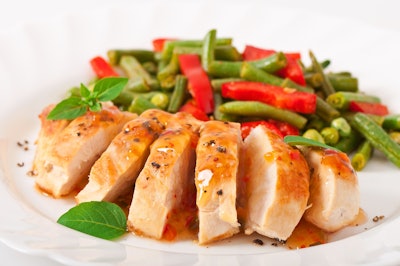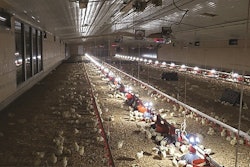
The incidence of woody breast and other detrimental breast meat conditions is dropping in the U.S., but a significant percentage of meat is still affected. Breeders, researchers and integrators continue to search for solutions.
Breast meat myopathies
While dark meat is rising in popularity in the U.S., boneless skinless breast meat – coming from the bird’s pectoralis major muscle – is still the most wanted cut.
Since the early 1960’s, the chicken and turkey industries experienced sporadic cases of breast meat myopathies which reduce or eliminate the value of meat. Breeding companies and poultry producers bred and managed birds to avoid those issues. However, since 2010, three main conditions affecting the pectoralis major – woody breast syndrome, white striping and spaghetti, or stringy-spongy, breast – progressively emerged as the most challenging.
According to a report on myopathies published by Aviagen in 2019, before 2010, these myopathies may have existed but not been recognized in the processing plant. Nevertheless, they were encountered at increasing rates in the following decade.
Economic and public impacts
White striping doesn’t impact the value of the meat but can slightly lower its protein content and quality. When woody and spaghetti breast is severe, it affects consumer acceptance of the meat and devalues the product.
The economic impact of these conditions is unclear. Sometimes the worst impacted meat is trimmed away in deboning and some meat is recovered. Other times, meat with mild cases is diverted to other uses.
Animal activist groups attack the industry by highlighting these conditions, too. Since these issues affect taste and mouthfeel of meat, these arguments reach consumers and negatively impact their perception of the industry.
Causes
Research shows breast meat myopathies can occur in all modern broiler genotypes, including slower-growing crosses, Aviagen said. The risk of these conditions is higher when birds are grown to heavier weights, more than 6.6 pounds or 3 kilograms, at older ages.
Aviagen Group’s Chief Technical Officer Dr. Alfons Koerhuis said the cause of these conditions is not fully understood. There’s a small genetic role, he said, but more than 65% of the causation likely lies with non-genetic factors.
“Some key non-genetic factors impacting woody breast, for example, are nutritional specifications; such as protein and antioxidant levels; nutrient sources, such as animal versus vegetable protein; growth profile, particularly early and mid-phase growth; and house environment, including ventilation and temperature,” he said.
As for spaghetti, Koerhuis said there is evidence that the condition is possibly “exacerbated during processing due to inadequate carcass cooling, incorrect scald tank temperatures and excessive plucking.”
A leading researcher of myopathies in Europe, Dr. Massimiliano Petracci, a professor at the University of Bologna’s Department of Agricultural and Food Sciences, said the origin of these conditions is indirectly associated with the rapid growth of breast muscles used in broiler meat production. On-farm factors can either mitigate or exacerbate the occurrence level and severity of myopathies, too.

Breeding adjustments
Aviagen said it adjusted its breeding goals to deal with those three main conditions as early as 2012. That change should have been evident in the field starting in 2018.
Koerhuis said Aviagen’s aim is to reduce the genetic tendency to express myopathies in the field.
“Detailed recording of myopathies in processing plants, combined with an accurate assessment of meat quality in live birds using state-of-the-art technology like 3D imaging tools, have been fundamental in this process,” Koerhuis said. “As a result, we have seen a reduction in our own broiler trials and in the field based on customer feedback.”
Moreover, he said Aviagen views reducing myopathies as part of its broader sustainability goal to further increase the resource efficiency of the animal.

Current incidence rate
It’s difficult to exactly say how often the condition occurs. Koerhuis said his customers and his company’s observations make it clear that the incidence of myopathies “has decreased significantly for a number of years.”
A leading researcher of the conditions in the U.S., Casey Owens, a Novus International professor of poultry science at the University of Arkansas, said some of the big bird plants – slaughtering birds at 8 pounds or more – can experience incidence as high as 20% but others can see less than 10%.

Slower growth?
The international poultry industry faces tremendous pressure concerning the growth rate of birds. In the U.S. and Europe, major food service and retail companies are signing onto pledges asking their suppliers to use only breeds which grow at a slower rate than the standard, commercial broiler breeds.
One given reason for this change is the myopathies. Petracci said there is truth to this. He cited a 2021 report based on data from the 2019 University of Guelph breed comparison study concluding faster-growing breeds had a higher incidence of myopathies than slower-growing breeds.
Koerhuis said scientific and field evidence clearly proves myopathies can occur at a range of bodyweights.
Managing the conditions
Owens said she’s worked with myopathies in the field for more than 10 years. When dealing with these conditions, integrators must carefully weigh the costs and benefits of their decisions.
Researchers and integrators looked at slowing down the growth rate using nutrition during certain periods of the grow-out to reduce the total incidence of myopathies. Birds with high breast yield grow quickly. So, if that growth rate can be slowed at periods of rapid growth for the bird that could be a short-term management strategy to avoid woody breast and other conditions.
Owens said research also shows feeding birds a lower density diet – with less protein and energy – will lower the incidence of woody breast. However, integrators are hard pressed to switch to a less efficient, more expensive feeding program.
She also said integrators can slaughter birds at lower weights to avoid the conditions, but then there is not as much meat produced.
Petracci said those are the strategies currently used in Europe: Reducing weight, when possible, at slaughter and trying to adjust growth rate by dietary means.
Aviagen recommends:
- At brooding: Provide adequate ventilation and access to quality feed and water. By 7 days of age, chicks should weight 4 times more than placement.
- During grow-out: Avoid sudden growth acceleration of more than 120 grams or .26 pounds per day after flock thinning. Minimize flock disturbances and wing flapping. Prevent high body temperatures during the mid- and late- growout phase and ventilate to ensure good airflow around the birds’ bodies.
Using additives
The industry is also examining specific feed additives for their effectiveness.
Owens said reducing the amino acid lysine during certain periods seems to slow the growth rate. When encountering higher levels of woody breast, Aviagen recommends dropping the lysine level in the diet to 85% of the advised amount during day 15 to day 32 of the grow-out cycle to significantly reduce the incidence and severity of conditions.
Because oxidative stress in the muscle is linked to the condition, there is interest in antioxidants, too. Owens said there’s research saying antioxidants are helpful. Phytates and chelated minerals, which reduce oxidative stress, are also drawing interest.
Dr. Tara York, a senior technical manager at AB Vista, shared research about her company’s enhanced E. coli phytase product, Quantum Blue. According to research from 2020 published in the journal Frontiers in Veterinary Science, the phytase product reduces the severity of woody breast by improving muscle oxidation and metabolism.
York was also the co-author of a 2016 study examining the role of trace minerals in myopathies. That study drew three conclusions: feeding to support the immune system and its antioxidant capacity aids in the reduction of woody breast; superdosing an enhanced E. coli phytase appears to allow for improvements in average daily gain while not increasing the most severe form of woody breast and increasing the overall trace mineral levels is also promising in reduction of woody breast.
Research shows fast growth leads to breast meat issues www.WATTAgNet.com/articles/40919
















